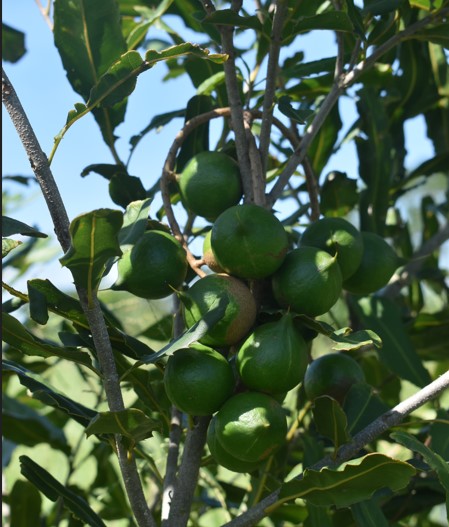A good farmer does not randomly decide what he wants to farm with and how he wants to go about it. No, he investigates the most profitable practice and crop that grows in his area, as well as how much soil and water are needed — that makes sense!
Rob and Keegan Hughes of Thulani Macs feel that way too. This father and son duo farm 20 km outside Empangeni in the Heatonville area. Rob is a property developer and owns a game farm. In 2019, they decided to take on farming after being inspired by the success of macadamia farmers in the area.
They acquired land with a good source of water and then approached Willie Vosloo from Agrico in Empangeni. He helped determine exactly where the irrigation points — and therefore the orchards — should be established. Soil preparation started in the beginning of 2020, and the first tree was planted in 2021.
Today, the 105 hectares of high-density orchards consist of 43 780 trees.

Rob Hughes, Willie Vosloo from Agrico and Keegan Hughes are proud of the macadamia trees that grow well through good planning.
Macadamia groves with micro-irrigation that are sensibly laid out
“We approached several macadamia farmers along the coast for information. They were eager to share advice,” Rob recalls. “But before we did anything, we first thought about it and asked: Does it make sense? We approach everything that way.
“We asked Willie to help plan the water supply,” says Rob. Agrico handles the design of the system, from surveying to layout. The farmer can install the system by himself or use contractors, but Agrico remains involved throughout.
For this farm, water is pumped from the Mhlatuze River and stored in an earth dam. It acts as a buffer dam and helps the silt settle down so cleaner water is pumped through the system.
Micro irrigation was set up for various reasons. A microsystem can easily be converted to drip irrigation if there is a water shortage in the future. One can also see when the apertures are blocked, and as a bonus, it helps to protect the orchard against wildfires.
There are two 73 kW motors connected to KSB pumps which direct water to the various blocks. The blocks are divided according to the water requirement of the soil type and the slope on which it stands.
Each pump has variable speed drive (VSD) which helps control the pressure at the different slopes and lowers the general electricity costs.
The system is built to apply 3,5 mm of water per day. Cycle lengths vary from three to six days, depending on the soil characteristics and the weather conditions.
After the irrigation planning, the land was cleared, and tillage began. Lime and gypsum were worked into the soil under the recommendation of an agronomist who identified the varying soil types. Ridges were made with a plough on which the irrigation pipes were laid and the trees were planted.

The young macadamia orchard of Thulani Macs.
Each tree can be identified with GPS guidance thanks to a system designed by Keegan. “We initially measured by hand where each tree should be in a block, but it was difficult to be accurate and time-consuming. This electronic system ensures that each tree stands three meters from its neighbours. It is quicker too,” Keegan explains.
The varieties they plant are A4, 695, 816, 863, 8.4 and N2. “We alternate two varieties per block, with four rows of one variety and then four of another. Between each row, we plant Napier grass which acts as a wind buffer,” he says. “These varieties are planted because the flowering periods overlap and ensure cross-pollination.”
An organic approach to macadamia cultivation
The Hughes follow an organic approach to their farming.
“We avoid chemical pesticides and fertilisers, and we have not yet needed to add any fertilisers. Leaf and sap tests indicated that our trees are happy,” Keegan says.
Instead, they use cow manure that has broken down into compost to feed the roots naturally. The kraal manure is supplied to them by a local cattle farmer.

The piggy system that can help to apply herbicide or fertiliser.
When an extra boost is needed in the future, the piggy system – a stainless steel tank that withstands pressure up to 10 bar – will assist in fertiliser application. It is connected to the water that flows towards the orchard; soluble or liquid fertiliser is poured into the “piggy’s” stomach and then the orchard is fertigated.
There are bees on the farm to help with pollination, a game fence that keeps bush pigs out and they have also erected posts for the forest buzzards that keep rats under control.
Furthermore, they use mulching to keep the moisture in the soil, cool the irrigation pipes and create a favourable environment for micro-organisms. It also controls weeds.
Watch it in action by clicking here
To locate your nearest branch, visit Agrico’s website at www.agrico.co.za or call Willie Vosloo on (+27)35-787-1949 or by mobile on +(27)82-571-2452. You can also watch how the micro-irrigation system works on this farm.










[…] Read how the AGRICO Micro-irrigation makes sense for this macadamia farm. […]
[…] AGRICO Micro-irrigation that makes sense […]